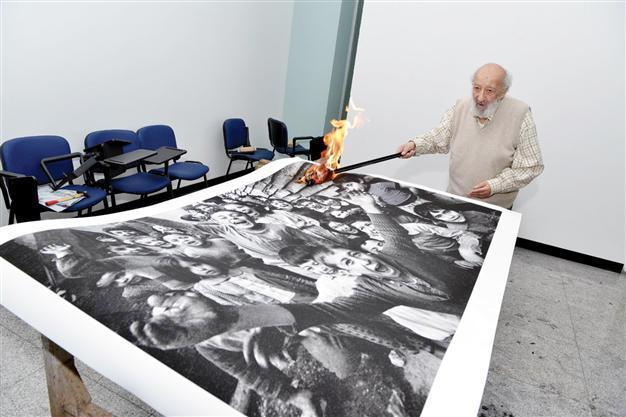Artists burn works to remember Sivas Massacre
ISTANBUL

Ara Güler. The burnt artworks will also be exhibited in Ankara, İzmir, Eskişehir and other Turkish cities before going on an international tour. At the same time, cultural officials also plan to collect the works in a book.
Lighting a flame of remembrance instead of the flames of fundamentalism, 35 prominent artists gathered on Nov. 19 to set fire to their works to commemorate the 35 mostly Alevi intellectuals who were burned to death in the 1993 Sivas Massacre and protest a court’s refusal to try those responsible.“The case is a crime against humanity and it should not exceed the statute of limitations. This is a project of responsibility for us,” the artists said in a joint statement. The organizer of the project was Bubi Hayom, who also burned one of his works in the event at the Atatürk Cultural Center in Beşiktaş.
Thirty-three intellectuals died on July 2, 1993, when a fundamentalist mob set fire to Sivas’ Madımak Hotel during an Alevi festival. Two hotel workers also died, while two assailants also perished while attacking the building.
A new museums for the Sivas Massacre
A Turkish court recently ruled that the statute of limitations on the case had run out, angering Alevis. Members of the community, however, became even more incensed after Prime Minister Recep Tayyip Erdoğan welcomed the ruling, saying, “Congratulations, to our nation and our country.”
Beşiktaş Mayor İsmail Ünal said he planned to collect the 35 burnt works in a new museum titled “Unutmamak Müzesi” (The Museum of not Forgetting) in the district’s Karanfilköy neighborhood. The museum will be made by architect Mustafa Toner and is expected open by the end of this year.
Participants in the project said the exhibition aims to ensure that people remember the killings and realize that the massacre should be declared a crime against humanity.
The burnt works will also be exhibited in Ankara, İzmir, Eskişehir and other Turkish cities before going on an international tour. At the same time, cultural officials also plan to collect the works in a book to be used as a catalogue for the exhibition.

The artists who burned works for the museum and the exhibition include Adnan Çoker, Ara Güler, Devrim Erbil, Mehmet Güleryüz, Tomur Atagök, Süleyman Saim Tekcan, İpek Düben, Komet, Seyhun Topuz, Utku Varlık, Meriç Hızal, Ferit Özşen, Halil Akdeniz, Adem Genç, Koray Ariş, Mustafa Ata, Zahit Büyükişleyen, Hanefi Yeter, Mustafa Altıntaş, Balkan Naci İslimyeli, Tülin Onat, Osman Dinç, Şenol Yorozlu, Yusuf Taktak, Bünyamin Özgül Tekin, Nedret Sekban, Aydın Ayan, Mehmet Günyeli, Ahmet Oran, Mithat Şen, Bedri Baykam, İrfan Okan, Mustafa Karyağdı, Seçkin Pirim, as well as Hayom.
An Islamist mob perpetrated the massacre after becoming agitated mainly by the presence of popular atheist writer Aziz Nesin, who was then translating Salman Rushdie’s “Satanic Verses.” The Madımak Hotel has since become a symbol of the discrimination faced by the Alevi community, who has long asked the state to turn the Madımak into a memorial museum. The government, however, only converted the museum into a science center, while including a plaque with the names of all those who died, including the two attackers – an action that further incensed the community.
Recently, in June thousands gathered in the Anatolian-side Istanbul district of Kadıköy to mark the upcoming 20th anniversary of the Sivas Massacre. A number of unions as well as the Taksim Solidarity Platform, a local organization that launched the Gezi Park protests, also attended the demonstration. A representative of the platform made a speech emphasizing that their demands had not yet been met by the government.
















